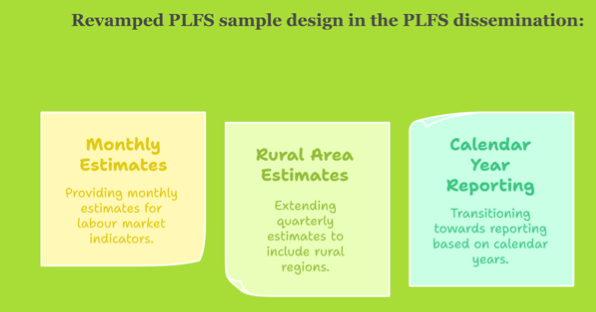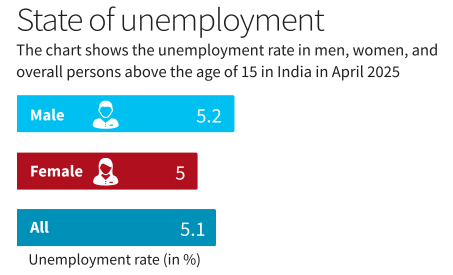Syllabus: GS3/Economy; Employment
Context
- The latest Periodic Labour Force Survey (PLFS) data, released by the Ministry of Statistics & Programme Implementation (MoSPI), shows that India’s unemployment rate stood at 5.1% in April 2025.
Periodic Labour Force Survey (PLFS)
- About: It is conducted by the MoSPI to assess employment and unemployment trends in India.
- It provides key labour market indicators, including the Labour Force Participation Rate (LFPR), Worker Population Ratio (WPR), and Unemployment Rate (UR).
- Features:
- Revamped Sampling Design (2025): The survey now includes monthly estimates for both rural and urban areas, improving data accuracy.
- Current Weekly Status (CWS) Approach: Measures employment status based on activity in the last seven days preceding the survey.
- Expanded Coverage: The sample size has increased to 22,692 First Stage Units (FSUs), covering both rural and urban sectors.
- Earlier, 12,800 FSUs surveyed in PLFS up to December, 2024.
- Annual Reports: PLFS results are now released based on the calendar year, ensuring timely updates.

Key Findings of the PLFS Report
- Unemployment Rate: It is defined as the percentage of persons unemployed among the persons in the labour force.
- Overall (persons aged 15 years and above): 5.1%
- Male: 5.2%; Female: 5.0%
- Rural: 4.5%; Urban: 6.5%
- Youth among urban females (15-29 years): 23.7%

- Labour Force Participation Rate (LFPR): It is defined as the percentage of persons in the labour force (i.e. working or seeking or available for work) in the population.
- For persons aged 15 years and above: 55.6%
- Rural: 58.0%; Urban: 50.7%
- Male: 79.0% (rural areas); 75.3% (urban areas)
- Female: 38.2% (rural areas); 25.7% (urban areas)
- Worker Population Ratio (WPR): It measures employed persons as a percentage of the total population.
- Overall: 52.8%
- Rural WPR: 55.4%; Urban WPR: 47.4%
- Female WPR: 36.8% (rural areas); 23.5% (urban areas)
Significance of the Findings
- The rise in female labour force participation, particularly in rural areas, signifies increasing economic engagement.
- However, high youth unemployment among urban females raises concerns about gender disparities, job availability, and skill gaps.
- The revamped PLFS model provides monthly employment estimates, but timely implementation of corrective measures remains a challenge.